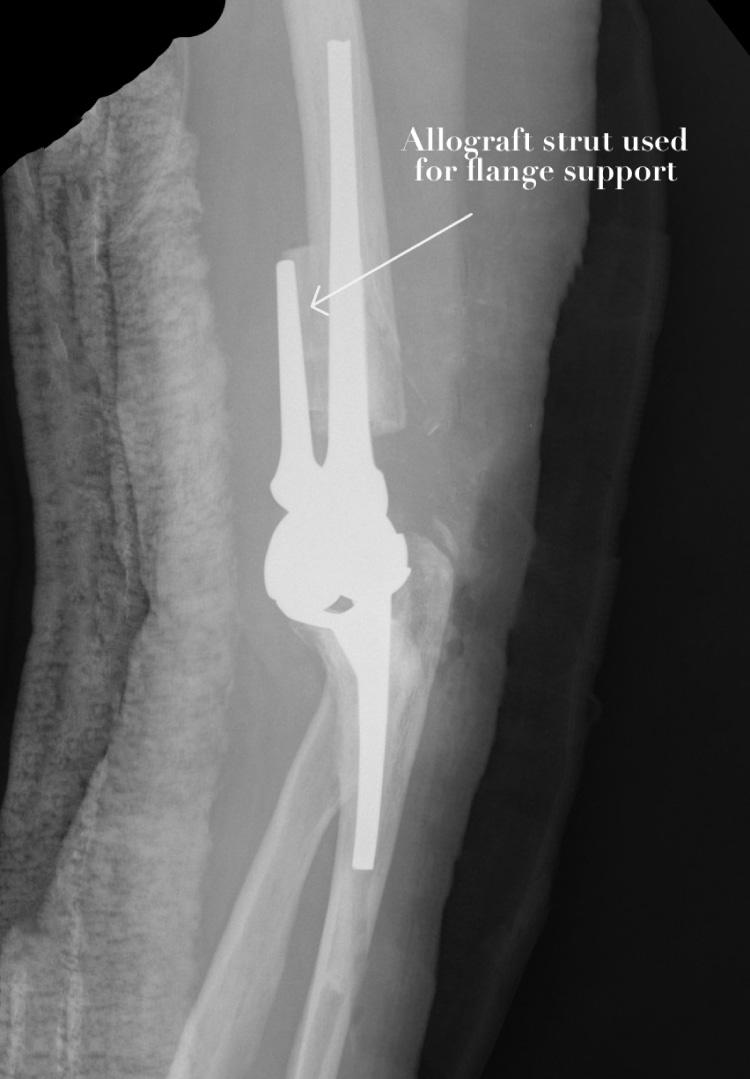Physical Address
304 North Cardinal St.
Dorchester Center, MA 02124
Not uncommonly, substantial bone loss is encountered at the time of revision elbow arthroplasty. A successful reconstruction in these circumstances requires bone loss management. Several bone augmentation techniques are available depending on the nature and extent of bone deficiency. They include impaction of cancellous bone in a contained bone defect (impaction grafting), use of a structural allograft to support the prosthesis (allograft-prosthetic composite), or use of plates of cortical bone (struts). The following two chapters describe impaction grafting and allograft-prosthetic composite techniques. In this chapter we will review the use of cortical struts in revision elbow arthroplasty.
Use of cortical struts of allograft bone was first described for bone augmentation of the femur in revision hip arthroplasty and for the surgical management of periprosthetic femoral fractures. To some extent, cortical struts provide the same support that would be provided by a metal plate, and additionally they have the potential to unite to host bone, resulting in permanent bone augmentation. In hip surgery, struts were commonly used in combination with other stabilizing techniques (revision stems and metal plates), and occasionally they were considered for prophylactic augmentation of bone to prevent postoperative fractures. More recently, the development of modern tapered fluted stems and dedicated periarticular locking plates has resulted in less common use of struts in revision hip surgery, but they are still being used for a number of indications.
Use of cortical struts is very appealing in revision elbow arthroplasty, both on the humeral and the ulnar side. Metal plates fixed with screws are oftentimes more difficult to apply around the elbow joint due to the smaller diameter of the bones compared to the lower extremity and the almost universal use of cemented stems, where the combination of the stem and the cement column occupies most of the canal. Struts are typically fixed with cerclage wires or cables, which avoids the need to fit screws around the cemented prosthesis. However, it is important to note that modern metal plates do provide the option of cable or wire cerclage fixation and that we have been successful in sneaking nonlocking screws around stems almost universally. Other attractive features of strut augmentation include the possibility of cutting them intraoperatively to the ideal length and width for each application and the potential for additional cortical bone if plate and screws are also being used.
One very specific benefit of using cortical struts around the elbow is the need to provide structural support to the anterior flange of the humeral component that most systems rely upon for rotational, sagittal, and axial stability. In the revision setting, the anterior cortex of the distal humerus is oftentimes compromised or absent, and autograft is no longer an option as opposed to the primary setting. Struts are extremely useful to provide the missing link between the humeral flange and the anterior cortex ( Fig. 107.1 ).

Use of cortical allograft struts does present a number of potential disadvantages, including cost, limited availability in some countries and institutions, the potential for infection transmission, additional time spent in surgery achieving adequate contouring, the need to expose relatively large surfaces of bone, suboptimal rotational stability compared to plates and screw fixation, and bulk. Bulk can be particularly relevant on the ulnar side of the elbow joint, where skin closure can be difficult after strut application.
Become a Clinical Tree membership for Full access and enjoy Unlimited articles
If you are a member. Log in here